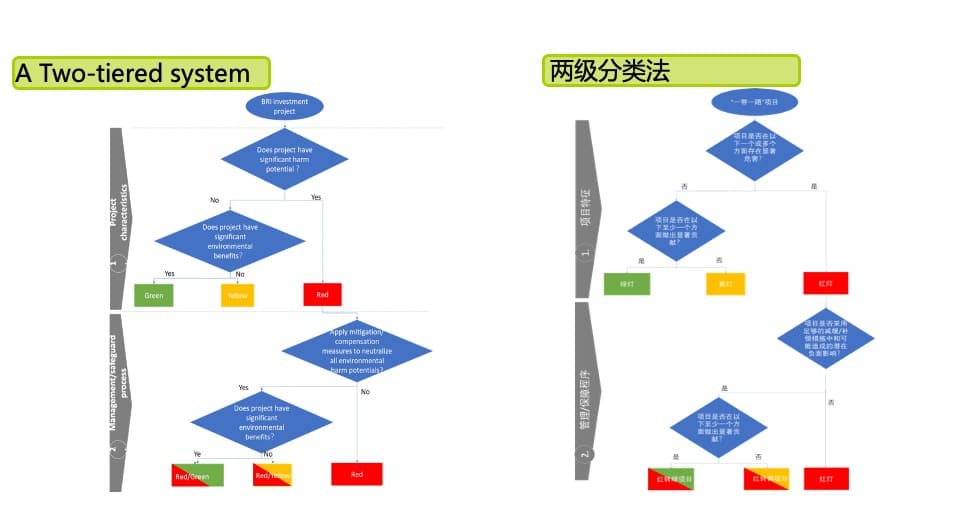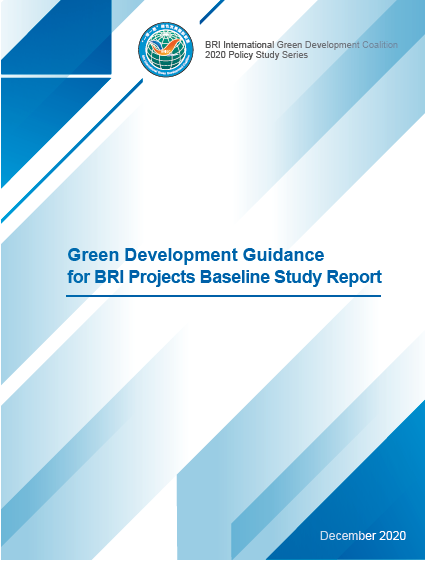On December 1, during the Policy Studies Release and Launching of BRI Green Development Institute Event in Beijing, the BRI International Green Development Coalition (BRIGC) released the “Green Development Guidance for BRI Projects Baseline Study Report” (formerly known as “Traffic Light System”). The Guidance provides a framework for classifying BRI projects as well as a project list along 3 categories (red, yellow and green) depending on their environmental impacts.
Among the participants, such as Vice Minister of the Ministry of Ecology and Environment (MEE) Zhao Yingmin, Convener of the BRIGC Erik Solheim, DDG of the Ministry of Foreign Affairs Guo Xuejun and DDG of the NDRC Mr. Yuan Feng, Christoph NEDOPIL WANG, Director of the Green BRI Center at IIGF and the lead author of the report, together with Manish Bapna, Executive Vice President and Managing Director of World Resources Institute (WRI) introduced the Guidance.
The Guidance proposes a measure to classify projects into three categories of “red”, “yellow”, and “green” according to their positive and negative impact on the three environmental dimensions of climate, pollution, and biodiversity. This will allow for acceleration of green and deceleration of brown BRI investments.

Christoph Nedopil, introduced how the Guidance proposes to classify projects. He pointed out that a two-tiered system has been developed to allow for a transparent process and localization of the environmental evaluation: in the first step, the project characteristics are evaluated in regard to their environmental risks (“Do-no-significant-harm”) and nature-positive contributions. For projects that are at risk of significant harm, the second process-step analyzes whether sufficient project management and safeguards are available to minimize environmental impacts: If the project adopts sufficient environmental management measures to mitigate negative environmental impact and promote the realization of environmental objectives, the project category can be upgraded and adjusted accordingly to ‘red/yellow’ or ‘red/green’.

As a result, for example, coal and fossil fuel projects due to their negative climate impacts are “red” projects, while solar power is a “green” project. Hydropower, due to its risk for biodiversity would be red – but if sufficient safeguards are applied – it would be red-green due to its contribution to an emission-free energy system. Similarly, railroads are red-green due to their potential negative impact on biodiversity but can move to green with the application of sufficient safeguards.
The Guidance recommends that based on the classification of a project enterprises, financial institutions, and relevant competent authorities conduct differentiated management of the three types of projects throughout the project cycle according to environmental risks and impacts. The ‘Report’ recommends that they can adopt different forms on the decision-making process, risk management, environmental impact evaluation, financing conditions, performance evaluation, and information disclosure.
Christoph Nedopil Wang said that the “Report” puts forward five objectives:
- First, to build an outward investment ecological and environmental risk prevention system based on project classification, streamline methods to assess and reduce potential ecological and environmental impacts of projects, and align BRI projects to the United Nations Sustainable Development Goals (SDGs) and Paris Agreement climate goals, to share lessons and learnings with the green development to BRI countries.
- Second, to improve outward investment regulatory mechanisms and lifecycle environmental management mechanisms and formulate green development guidelines tailored to the needs and realities of different stakeholders.
- Third, to provide early warning mechanisms and green solutions to mitigate negative ecological, environmental, and climate impacts for Belt and Road Initiative projects, and improve pollution prevention and control and green development.
- Fourth, to clarify the positive and negative lists of outward investment projects in the Belt and Road area, based on which to provide the basis and guidance for government regulatory authorities, financial institutions and enterprises.
- Fifth, to prepare for the application of the Green Development Guidance and form green demonstration projects.
The Green Development Guidance for BRI Projects was officially launched in December 2019, with the support by the Foreign Environmental Cooperation Cerner, MEE (MEPFECO); China Environmental Impact Assessment, MEE (ACEE), World Resources Institute (WRI); ClientEarth; The Children’s Investment Fund Foundation (CIIF) and other institutions. The project constructs the policy framework and practical guidelines for the green development of the BRI from multiple perspectives and forms a series of targeted research reports. This report is the phase one of the baseline research report.
For more information and media inquiries, please contact us at info@green-bri.org.





Comments are closed.